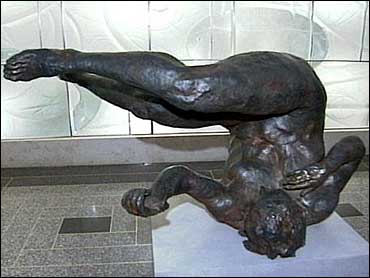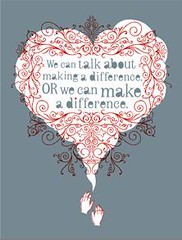Crouching Towards Bethlehem
I recently conducted a google search for the term “nappy-headed ho’s” and to my dismay, the phrase garnered 2,530,000 hits including a sponsored link from a site that is now selling t-shirts extolling the statement “I am a nappy-headed ho.” Other top-rated links included a Yahoo site responding to the reader question, “What is a nappy-headed ho?” and at least 400 YouTube videos either in support or calling for the resignation of Don Imus for saying the term “nappy-headed hos.” I think you get my point. Suddenly “nappy-headed ho” is part of our verbal vernacular and it seems that every news article, every television report, every blog and every video site deems it entirely appropriate to keep repeating, ad nauseum, this phrase that has outraged the nation and most of the talk-shows advertisers.
As offensive and repugnant as Imus’ comments were, I find can’t help but wonder where both the listening public and the show’s advertisers have been for the last twenty years during his previous broadcasts. While this particular phrase is a first for Imus, this type of communication is not. As noble as Don’s reported extracurricular activities might be, this is not Imus’ first foray in using terminology that is racist, sexist, misogynistic, and language that is rude, crude, mean, spiteful and nasty. Whether this is schtick or whether it is genuine makes no difference to this non-listener.
Used to be, in the not so distant past, the news media either bleeped out provocative and offensive language; for example, the word “fuck” was always spelled out “f*@k.” Even the MTV video awards had a short time delay when broadcasting in an effort to avoid the embarrassment of airing celebrities cursing or embarrasing their sponsors. Mel Gibson’s anti-semetic diatribe was censored. Michael Richard’s racist nervous breakdown was edited for national television and even Janet Jackson’s so-called “wardrobe malfunction” was called as such, rather than “nipple alert” or “booby trap.” Further, the pesky breast at hand was always covered up in the subsequent mainstream media coverage.
So why is the phrase “nappy headed ho’s” acceptable language to repeat? Why is this exact terminology the most repeated part of the discussion? Is this supposed to engage us? Is this supposed to outrage us further? Are we now, as a culture, addicted to shtick or to shock, or to both?
What is the responsibility of the media in reporting and commenting accurately and explicitly? In the last few days, amid the grief and the agony of the massacre at Virginia Tech, I came upon an article in the L.A. Times with this title: “Amid controversy, NBC ratings rise by showing Virginia Tech gunman images.” The article goes on to report that “While many viewers were repulsed by NBC's decision to broadcast videos and photos from the Virginia Tech gunman, the scoop translated into a ratings bonanza for the network, and further relates how "NBC Nightly News With Brian Williams," which led its Wednesday broadcast with rambling diatribes the killer recorded and mailed to the network, easily bested the competing newscasts on ABC and CBS.
Does the general public really need to be continually assaulted with the images and verbal “manifesto” (so to speak) of a madman preparing to go on a homicidal rampage? And is it possible that anyone with a heart really cares to know that NBC’s ratings are up this week? NBC News said in a statement issued late last week that it gave "careful consideration" to distributing the material and that it would limit the usage of the videos. In the meantime, there seems to be widespread circulation of the photos and videos all over the mainstream media and over 7,000 videos on YouTube. 7,000 videos!
And yet, among all of this virulent frothing of offensiveness, the government still wants to limit how many coffins we see of dead soldiers in an effort to protect the public from morbid imagery and unfortunate spectacle. It is a sobering time in this nation of ours. The images before us and the decisions being made--the state of our collective soul is at stake in a race for ratings in the guise of information and entertainment, power and control. Those that refute this suggest that the images and messages being thrust upon us now are actually helping prevent horrors like this from happening again. But I, for one, find it hard to believe that the relentless repetition of offensive messages and repugnant behavior is in any way prescriptive. I can’t imagine how this could possibly assist in efforts to rise above our penchant for brutal violence and mass propaganda. That the killer referenced the brutal murders at Columbine quashes this rationale instantly.
One year after 9/11, artist Eric Fischl created a bronze sculpture in Rockefeller Center that was meant to commemorate those who jumped or fell to their deaths from the World Trade Center. Titled "Tumbling Woman," it depicted a naked woman with her arms and legs flailing above her head, as if in a backward somersault.

As soon as it went on view, it drew complaints, and after only a few days on display, it was abruptly draped in cloth and subsequently surrounded by a curtain wall.
"The sculpture was not meant to hurt anybody," Fischl said in a statement. "It was a sincere expression of deepest sympathy for the vulnerability of the human condition. Both specifically towards the victims of Sept. 11 and towards humanity in general."
Nevertheless, the sculpture was removed, and to this day it has never been displayed again. All that remains publicly available is a poem by Fischl, which appeared on a plaque near the sculpture, and read:
We watched,
disbelieving and helpless,
on that savage day.
People we love
began falling,
helpless and in disbelief
Five and a half years later, we are still watching and disbelieving. The difference now is that we are not helpless. But what are designers doing to communicate the worlds injustices? Last week I saw Mirko Ilic give a presentation wherein he questioned the audience as to why there wasn't any major art and design representing what is going on now in our culture. Where is this generations Guernica? Where is our Desert Storm memorial?
As designers and communicators, we can make a difference. We must. If not, what else can we do? If not now, when?
As offensive and repugnant as Imus’ comments were, I find can’t help but wonder where both the listening public and the show’s advertisers have been for the last twenty years during his previous broadcasts. While this particular phrase is a first for Imus, this type of communication is not. As noble as Don’s reported extracurricular activities might be, this is not Imus’ first foray in using terminology that is racist, sexist, misogynistic, and language that is rude, crude, mean, spiteful and nasty. Whether this is schtick or whether it is genuine makes no difference to this non-listener.
Used to be, in the not so distant past, the news media either bleeped out provocative and offensive language; for example, the word “fuck” was always spelled out “f*@k.” Even the MTV video awards had a short time delay when broadcasting in an effort to avoid the embarrassment of airing celebrities cursing or embarrasing their sponsors. Mel Gibson’s anti-semetic diatribe was censored. Michael Richard’s racist nervous breakdown was edited for national television and even Janet Jackson’s so-called “wardrobe malfunction” was called as such, rather than “nipple alert” or “booby trap.” Further, the pesky breast at hand was always covered up in the subsequent mainstream media coverage.
So why is the phrase “nappy headed ho’s” acceptable language to repeat? Why is this exact terminology the most repeated part of the discussion? Is this supposed to engage us? Is this supposed to outrage us further? Are we now, as a culture, addicted to shtick or to shock, or to both?
What is the responsibility of the media in reporting and commenting accurately and explicitly? In the last few days, amid the grief and the agony of the massacre at Virginia Tech, I came upon an article in the L.A. Times with this title: “Amid controversy, NBC ratings rise by showing Virginia Tech gunman images.” The article goes on to report that “While many viewers were repulsed by NBC's decision to broadcast videos and photos from the Virginia Tech gunman, the scoop translated into a ratings bonanza for the network, and further relates how "NBC Nightly News With Brian Williams," which led its Wednesday broadcast with rambling diatribes the killer recorded and mailed to the network, easily bested the competing newscasts on ABC and CBS.
Does the general public really need to be continually assaulted with the images and verbal “manifesto” (so to speak) of a madman preparing to go on a homicidal rampage? And is it possible that anyone with a heart really cares to know that NBC’s ratings are up this week? NBC News said in a statement issued late last week that it gave "careful consideration" to distributing the material and that it would limit the usage of the videos. In the meantime, there seems to be widespread circulation of the photos and videos all over the mainstream media and over 7,000 videos on YouTube. 7,000 videos!
And yet, among all of this virulent frothing of offensiveness, the government still wants to limit how many coffins we see of dead soldiers in an effort to protect the public from morbid imagery and unfortunate spectacle. It is a sobering time in this nation of ours. The images before us and the decisions being made--the state of our collective soul is at stake in a race for ratings in the guise of information and entertainment, power and control. Those that refute this suggest that the images and messages being thrust upon us now are actually helping prevent horrors like this from happening again. But I, for one, find it hard to believe that the relentless repetition of offensive messages and repugnant behavior is in any way prescriptive. I can’t imagine how this could possibly assist in efforts to rise above our penchant for brutal violence and mass propaganda. That the killer referenced the brutal murders at Columbine quashes this rationale instantly.
One year after 9/11, artist Eric Fischl created a bronze sculpture in Rockefeller Center that was meant to commemorate those who jumped or fell to their deaths from the World Trade Center. Titled "Tumbling Woman," it depicted a naked woman with her arms and legs flailing above her head, as if in a backward somersault.

As soon as it went on view, it drew complaints, and after only a few days on display, it was abruptly draped in cloth and subsequently surrounded by a curtain wall.
"The sculpture was not meant to hurt anybody," Fischl said in a statement. "It was a sincere expression of deepest sympathy for the vulnerability of the human condition. Both specifically towards the victims of Sept. 11 and towards humanity in general."
Nevertheless, the sculpture was removed, and to this day it has never been displayed again. All that remains publicly available is a poem by Fischl, which appeared on a plaque near the sculpture, and read:
We watched,
disbelieving and helpless,
on that savage day.
People we love
began falling,
helpless and in disbelief
Five and a half years later, we are still watching and disbelieving. The difference now is that we are not helpless. But what are designers doing to communicate the worlds injustices? Last week I saw Mirko Ilic give a presentation wherein he questioned the audience as to why there wasn't any major art and design representing what is going on now in our culture. Where is this generations Guernica? Where is our Desert Storm memorial?
As designers and communicators, we can make a difference. We must. If not, what else can we do? If not now, when?


















1 Comments:
How we unravel this imbroglio of mixed messages that seek to define a culture that is already in such a state of disharmony is the greatest challenge that we face. We are in a state of shock and horror when we think about the VA tech massacre and yet we sit and eat our dinner while the TV broadcasts a murderer's venomous diatribe. I think the media's bombardment of these events...the CONSTANT replaying of the images and the words make us numb to the reality of events like these. The fact that we watch it on TV...the same TV that we see the Sopranos and Friends on creates a sense of unreality. The question is, how do we re-engage with each other? We are too removed from each other....through t.v, e-mail, text messaging, blogging, the internet, human contact is sacrificed and the price of that is that we do not identify with each other anymore. If we cannot see the common thread of humanity in each and every person that we come into contact with, then mass killings and a culture of violence will prevail.
Post a Comment
<< Home